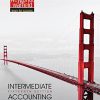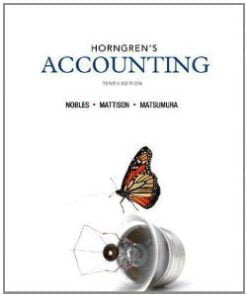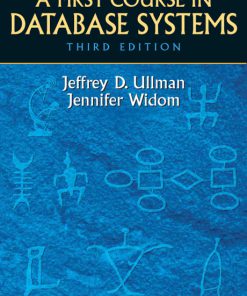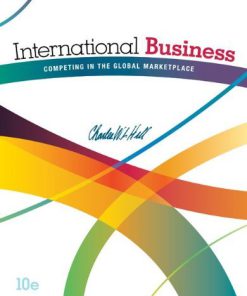Solution Manual for Management Information Systems 16th by Laudon
$35.00 Original price was: $35.00.$26.50Current price is: $26.50.
Solution Manual for Management Information Systems 16th by Laudon
This is completed downloadable of Solution Manual for Management Information Systems 16th by Laudon
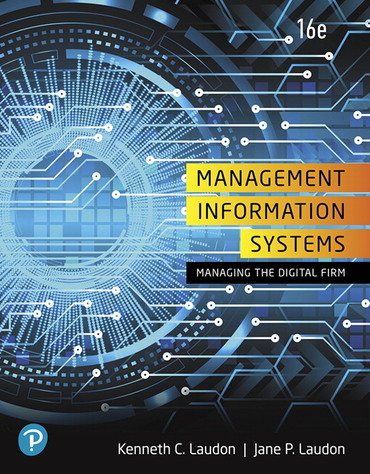
Product Details:
- ISBN-10 : 0135191793
- ISBN-13 : 978-0135191798
- Author: Kenneth C. Laudon, Jane Price Laudon
The authoritative, case-based study of IS in business today
Management Information Systems: Managing the Digital Firm provides the most comprehensive overview of information systems used by business firms today, while drawing connections between MIS and business performance. The Laudons are known for their outstanding real-world case studies, which describe how well-known companies use IT to solve problems and achieve business objectives. Students develop sought-after skills, such as leading IS-related management discussions and using IT to meet bottom-line results. Each chapter of the 16th edition features all-new Interactive Sessions, new Video Cases, and a new Career Opportunities section building practical job-seeking skills.
Table of Content:
- Chapter 1 Information Systems in Global Business Today
- Learning Objectives
- Chapter Cases
- Video Cases
- 1-1 How are information systems transforming business, and why are they so essential for running and managing a business today?
- How Information Systems are Transforming Business
- What’s New in Management Information Systems?
- Globalization Challenges and Opportunities: A Flattened World
- The Emerging Digital Firm
- Strategic Business Objectives of Information Systems
- Operational Excellence
- New Products, Services, and Business Models
- Customer and Supplier Intimacy
- Improved Decision Making
- Competitive Advantage
- Survival
- 1-2 What is an information system? How does it work? What are its management, organization, and technology components? Why are complementary assets essential for ensuring that information systems provide genuine value for organizations?
- What Is an Information System?
- Dimensions of Information Systems
- Organizations
- Management
- Information Technology
- It Isn’t Just Technology: A Business Perspective on Information Systems
- Complementary Assets: Organizational Capital and the Right Business Model
- 1-3 What academic disciplines are used to study information systems, and how does each contribute to an understanding of information systems?
- Technical Approach
- Behavioral Approach
- Approach of This Text: Sociotechnical Systems
- 1-4 How will MIS help my career?
- The Company
- Position Description
- Job Requirements
- Interview Questions
- Author Tips
- Review Summary
- Key Terms
- Review Questions
- Discussion Questions
- Hands-On MIS Projects
- Management Decision Problems
- Improving Decision Making: Using Databases to Analyze Sales Trends
- Improving Decision Making: Using the Internet to Locate Jobs Requiring Information Systems Knowledge
- Collaboration and Teamwork Project
- Selecting Team Collaboration Tools
- Chapter 1 References
- Chapter 2 Global E-business and Collaboration
- Learning Objectives
- Chapter Cases
- Video Cases
- 2-1 What are business processes? How are they related to information systems?
- Business Processes
- How Information Technology Improves Business Processes
- 2-2 How do systems serve the different management groups in a business, and how do systems that link the enterprise improve organizational performance?
- Systems for Different Management Groups
- Transaction Processing Systems
- Systems for Business Intelligence
- Systems for Linking the Enterprise
- Enterprise Applications
- Enterprise Systems
- Supply Chain Management Systems
- Customer Relationship Management Systems
- Knowledge Management Systems
- Intranets and Extranets
- E-business, E-commerce, and E-government
- 2-3 Why are systems for collaboration and social business so important, and what technologies do they use?
- What Is Collaboration?
- What is Social Business?
- Business Benefits of Collaboration and Social Business
- Building a Collaborative Culture and Business Processes
- Tools and Technologies for Collaboration and Social Business
- E-mail and Instant Messaging (IM)
- Wikis
- Virtual Worlds
- Collaboration and Social Business Platforms
- Virtual Meeting Systems
- Cloud Collaboration Services
- Microsoft SharePoint and IBM Notes
- Enterprise Social Networking Tools
- Checklist for Managers: Evaluating and Selecting Collaboration and Social Software Tools
- 2-4 What is the role of the information systems function in a business?
- The Information Systems Department
- Organizing the Information Systems Function
- 2-5 How will MIS help my career?
- The Company
- Position Description
- Job Requirements
- Interview Questions
- Author Tips
- Review Summary
- Key Terms
- Review Questions
- Discussion Questions
- Hands-On MIS Projects
- Management Decision Problems
- Improving Decision Making: Using a Spreadsheet to Select Suppliers
- Achieving Operational Excellence: Using Internet Software to Plan Efficient Transportation Routes
- Collaboration and Teamwork Project
- Identifying Management Decisions and Systems
- Chapter 2 References
- Chapter 3 Information Systems, Organizations, and Strategy
- Learning Objectives
- Chapter Cases
- Video Cases
- 3-1 Which features of organizations do managers need to know about to build and use information systems successfully?
- What Is an Organization?
- Features of Organizations
- Routines and Business Processes
- Organizational Politics
- Organizational Culture
- Organizational Environments
- Disruptive Technologies: Riding the Wave
- Organizational Structure
- Other Organizational Features
- 3-2 What is the impact of information systems on organizations?
- Economic Impacts
- Organizational and Behavioral Impacts
- IT Flattens Organizations
- Postindustrial Organizations
- Understanding Organizational Resistance to Change
- The Internet and Organizations
- Implications for the Design and Understanding of Information Systems
- 3-3 How do Porter’s competitive forces model, the value chain model, synergies, core competencies, and network economics help companies develop competitive strategies using information systems?
- Porter’s Competitive Forces Model
- Traditional Competitors
- New Market Entrants
- Substitute Products and Services
- Customers
- Suppliers
- Information System Strategies for Dealing with Competitive Forces
- Low-Cost Leadership
- Product Differentiation
- Focus on Market Niche
- Strengthen Customer and Supplier Intimacy
- The Internet’s Impact on Competitive Advantage
- Smart Products and the Internet of Things
- The Business Value Chain Model
- Extending the Value Chain: The Value Web
- Synergies, Core Competencies, and Network-Based Strategies
- Synergies
- Enhancing Core Competencies
- Network-Based Strategies
- Network Economics
- Virtual Company Model
- Business Ecosystems and Platforms
- 3-4 What are the challenges posed by strategic information systems, and how should they be addressed?
- Sustaining Competitive Advantage
- Aligning IT with Business Objectives
- Management Checklist: Performing a Strategic Systems Analysis
- Managing Strategic Transitions
- 3-5 How will MIS help my career?
- The Company
- Position Description
- Job Requirements
- Interview Questions
- Author Tips
- Review Summary
- Key Terms
- Review Questions
- Discussion Questions
- Hands-On MIS Projects
- Management Decision Problems
- Improving Decision Making: Using a Database to Clarify Business Strategy
- Improving Decision Making: Using Web Tools to Configure and Price an Automobile
- Collaboration and Teamwork Project
- Identifying Opportunities for Strategic Information Systems
- Chapter 3 References
- Chapter 4 Ethical and Social Issues in Information Systems
- Learning Objectives
- Chapter Cases
- Video Cases
- 4-1 What ethical, social, and political issues are raised by information systems?
- A Model for Thinking about Ethical, Social, and Political Issues
- Five Moral Dimensions of the Information Age
- Key Technology Trends that Raise Ethical Issues
- 4-2 What specific principles for conduct can be used to guide ethical decisions?
- Basic Concepts: Responsibility, Accountability, and Liability
- Ethical Analysis
- Candidate Ethical Principles
- Professional Codes of Conduct
- Some Real-World Ethical Dilemmas
- 4-3 Why do contemporary information systems technology and the Internet pose challenges to the protection of individual privacy and intellectual property?
- Information Rights: Privacy and Freedom in the Internet Age
- The European Directive on Data Protection
- Internet Challenges to Privacy
- Technical Solutions
- Property Rights: Intellectual Property
- Copyright
- Patents
- Trademarks
- Trade Secrets
- Challenges to Intellectual Property Rights
- 4-4 How have information systems affected laws for establishing accountability and liability and the quality of everyday life?
- Computer-Related Liability Problems
- System Quality: Data Quality and System Errors
- Quality of Life: Equity, Access, and Boundaries
- Balancing Power: Center Versus Periphery
- Rapidity of Change: Reduced Response Time to Competition
- Maintaining Boundaries: Family, Work, and Leisure
- Dependence and Vulnerability
- Computer Crime and Abuse
- Employment: Trickle-Down Technology and Reengineering Job Loss
- Equity and Access: Increasing Racial and Social Class Cleavages
- Health Risks: RSI, CVS, and Cognitive Decline
- 4-5 How will MIS help my career?
- The Company
- Position Description
- Job Requirements
- Interview Questions
- Author Tips
- Review Summary
- Key Terms
- Review Questions
- Discussion Questions
- Hands-On MIS Projects
- Management Decision Problems
- Achieving Operational Excellence: Creating a Simple Blog
- Improving Decision Making: Analyzing Web Browser Privacy
- Collaboration and Teamwork Project
- Developing a Corporate Code of Ethics
- Chapter 4 References
- Part Two Information Technology Infrastructure
- Chapter 5 IT Infrastructure and Emerging Technologies
- Learning Objectives
- Chapter Cases
- Video Cases
- 5-1 What is IT infrastructure, and what are the stages and drivers of IT infrastructure evolution?
- Defining IT Infrastructure
- Evolution of IT Infrastructure
- General-Purpose Mainframe and Minicomputer Era (1959 to Present)
- Personal Computer Era (1981 to Present)
- Client/Server Era (1983 to Present)
- Enterprise Computing Era (1992 to Present)
- Cloud and Mobile Computing Era (2000 to Present)
- Technology Drivers of Infrastructure Evolution
- Moore’s Law and Microprocessing Power
- The Law of Mass Digital Storage
- Metcalfe’s Law and Network Economics
- Declining Communications Costs and the Internet
- Standards and Network Effects
- 5-2 What are the components of IT infrastructure?
- Computer Hardware Platforms
- Operating System Platforms
- Enterprise Software Applications
- Data Management and Storage
- Networking/Telecommunications Platforms
- Internet Platforms
- Consulting and System Integration Services
- 5-3 What are the current trends in computer hardware platforms?
- The Mobile Digital Platform
- Consumerization of IT and BYOD
- Quantum Computing
- Virtualization
- Cloud Computing
- Edge Computing
- Green Computing
- High-Performance and Power-Saving Processors
- 5-4 What are the current computer software platforms and trends?
- Linux and Open Source Software
- Linux
- Software for the Web: Java, HTML, and HTML5
- HTML and HTML5
- Web Services and Service-Oriented Architecture
- Software Outsourcing and Cloud Services
- Software Packages and Enterprise Software
- Software Outsourcing
- Cloud-Based Software Services and Tools
- Mashups and Apps
- 5-5 What are the challenges of managing IT infrastructure and management solutions?
- Dealing with Platform and Infrastructure Change
- Management and Governance
- Making Wise Infrastructure Investments
- Total Cost of Ownership of Technology Assets
- Competitive Forces Model for IT Infrastructure Investment
- 5-6 How will MIS help my career?
- The Company
- Position Description
- Job Requirements
- Interview Questions
- Author Tips
- Review Summary
- Key Terms
- Review Questions
- Discussion Questions
- Hands-On MIS Projects
- Management Decision Problems
- Improving Decision Making: Using a Spreadsheet to Evaluate Hardware and Software Options
- Improving Decision Making: Using Web Research to Budget for a Sales Conference
- Collaboration and Teamwork Project
- Evaluating Server and Mobile Operating Systems
- Chapter 5 References
- Chapter 6 Foundations of Business Intelligence: Databases and Information Management
- Learning Objectives
- Chapter Cases
- Video Cases
- 6-1 What are the problems of managing data resources in a traditional file environment?
- File Organization Terms and Concepts
- Problems with the Traditional File Environment
- Data Redundancy and Inconsistency
- Program-Data Dependence
- Lack of Flexibility
- Poor Security
- Lack of Data Sharing and Availability
- 6-2 What are the major capabilities of database management systems (DBMS), and why is a relational DBMS so powerful?
- Database Management Systems
- How a DBMS Solves the Problems of the Traditional File Environment
- Relational DBMS
- Operations of a Relational DBMS
- Capabilities of Database Management Systems
- Querying and Reporting
- Designing Databases
- Normalization and Entity-Relationship Diagrams
- Non-relational Databases, Cloud Databases, and Blockchain
- Cloud Databases and Distributed Databases
- Blockchain
- 6-3 What are the principal tools and technologies for accessing information from databases to improve business performance and decision making?
- The Challenge of Big Data
- Business Intelligence Infrastructure
- Data Warehouses and Data Marts
- Hadoop
- In-Memory Computing
- Analytic Platforms
- Analytical Tools: Relationships, Patterns, Trends
- Online Analytical Processing (OLAP)
- Data Mining
- Text Mining and Web Mining
- Databases and the Web
- 6-4 Why are information policy, data administration, and data quality assurance essential for managing the firm’s data resources?
- Establishing an Information Policy
- Ensuring Data Quality
- 6-5 How will MIS help my career?
- The Company
- Position Description
- Job Requirements
- Interview Questions
- Author Tips
- Review Summary
- Key Terms
- Review Questions
- Discussion Questions
- Hands-On MIS Projects
- Management Decision Problems
- Achieving Operational Excellence: Building a Relational Database for Inventory Management
- Improving Decision Making: Searching Online Databases for Overseas Business Resources
- Collaboration and Teamwork Project
- Identifying Entities and Attributes in an Online Database
- Chapter 6 References
- Chapter 7 Telecommunications, the Internet, and Wireless Technology
- Learning Objectives
- Chapter Cases
- Video Cases
- 7-1 What are the principal components of telecommunications networks and key networking technologies?
- Networking and Communication Trends
- What Is a Computer Network?
- Networks in Large Companies
- Key Digital Networking Technologies
- Client/Server Computing
- Packet Switching
- TCP/IP and Connectivity
- 7-2 What are the different types of networks?
- Signals: Digital Versus Analog
- Types of Networks
- Local Area Networks
- Metropolitan and Wide Area Networks
- Transmission Media and Transmission Speed
- Bandwidth: Transmission Speed
- 7-3 How do the Internet and Internet technology work, and how do they support communication and e-business?
- What Is the Internet?
- Internet Addressing and Architecture
- The Domain Name System
- Internet Architecture and Governance
- The Future Internet: IPv6 and Internet2
- Internet Services and Communication Tools
- Internet Services
- Voice over IP
- Unified Communications
- Virtual Private Networks
- The Web
- Hypertext
- Web Servers
- Searching for Information on the Web
- Search Engines
- Mobile Search
- Semantic Search
- Social Search
- Visual Search and the Visual Web
- Intelligent Agent Shopping Bots
- Search Engine Marketing
- Sharing Information on the Web
- The Future Web
- 7-4 What are the principal technologies and standards for wireless networking, communication, and Internet access?
- Cellular Systems
- Wireless Computer Networks and Internet Access
- Bluetooth
- Wi-Fi and Wireless Internet Access
- WiMax
- RFID and Wireless Sensor Networks
- Radio Frequency Identification (RFID) and Near Field Communication (NFC)
- Wireless Sensor Networks
- 7-5 How will MIS help my career?
- The Company
- Position Description
- Job Requirements
- Interview Questions
- Author Tips
- Review Summary
- Key Terms
- Review Questions
- Discussion Questions
- Hands-On MIS Projects
- Management Decision Problems
- Improving Decision Making: Using Spreadsheet Software to Evaluate Wireless Services
- Achieving Operational Excellence: Using Web Search Engines for Business Research
- Collaboration and Teamwork Project
- Evaluating Smartphones
- Chapter 7 References
- Chapter 8 Securing Information Systems
- Learning Objectives
- Chapter Cases
- Video Cases
- 8-1 Why are information systems vulnerable to destruction, error, and abuse?
- Why Systems are Vulnerable
- Internet Vulnerabilities
- Wireless Security Challenges
- Malicious Software: Viruses, Worms, Trojan Horses, and Spyware
- Hackers and Computer Crime
- Spoofing and Sniffing
- Denial-of-Service Attacks
- Computer Crime
- Identity Theft
- Click Fraud
- Global Threats: Cyberterrorism and Cyberwarfare
- Internal Threats: Employees
- Software Vulnerability
- Newly Discovered Vulnerabilities in Microprocessor Design
- 8-2 What is the business value of security and control?
- Legal and Regulatory Requirements for Electronic Records Management
- Electronic Evidence and Computer Forensics
- 8-3 What are the components of an organizational framework for security and control?
- Information Systems Controls
- Risk Assessment
- Security Policy
- Disaster Recovery Planning and Business Continuity Planning
- The Role of Auditing
- 8-4 What are the most important tools and technologies for safeguarding information resources?
- Identity Management and Authentication
- Firewalls, Intrusion Detection Systems, and Anti-malware Software
- Firewalls
- Intrusion Detection Systems
- Anti-malware Software
- Unified Threat Management Systems
- Securing Wireless Networks
- Encryption and Public Key Infrastructure
- Securing Transactions with Blockchain
- Ensuring System Availability
- Controlling Network Traffic: Deep Packet Inspection
- Security Outsourcing
- Security Issues for Cloud Computing and the Mobile Digital Platform
- Security in the Cloud
- Securing Mobile Platforms
- Ensuring Software Quality
- 8-5 How will MIS help my career?
- The Company
- Position Description
- Job Requirements
- Interview Questions
- Author Tips
- Review Summary
- Key Terms
- Review Questions
- Discussion Questions
- Hands-On MIS Projects
- Management Decision Problems
- Improving Decision Making: Using Spreadsheet Software to Perform a Security Risk Assessment
- Improving Decision Making: Evaluating Security Outsourcing Services
- Collaboration and Teamwork Project
- Chapter 8 References
- Part Three Key System Applications for the Digital Age
- Chapter 9 Achieving Operational Excellence and Customer Intimacy: Enterprise Applications
- Learning Objectives
- Chapter Cases
- Video Cases
- 9-1 How do enterprise systems help businesses achieve operational excellence?
- What are Enterprise Systems?
- Enterprise Software
- Business Value of Enterprise Systems
- 9-2 How do supply chain management systems coordinate planning, production, and logistics with suppliers?
- The Supply Chain
- Information Systems and Supply Chain Management
- Supply Chain Management Software
- Global Supply Chains and the Internet
- Global Supply Chain Issues
- Demand-Driven Supply Chains: From Push to Pull Manufacturing and Efficient Customer Response
- Business Value of Supply Chain Management Systems
- 9-3 How do customer relationship management systems help firms achieve customer intimacy?
- What Is Customer Relationship Management?
- Customer Relationship Management Software
- Sales Force Automation
- Customer Service
- Marketing
- Operational and Analytical CRM
- Business Value of Customer Relationship Management Systems
- 9-4 What are the challenges that enterprise applications pose, and how are enterprise applications taking advantage of new technologies?
- Enterprise Application Challenges
- Next-Generation Enterprise Applications
- Social CRM
- Business Intelligence in Enterprise Applications
- 9-5 How will MIS help my career?
- The Company
- Position Description
- Job Requirements
- Interview Questions
- Author Tips
- Review Summary
- Key Terms
- Review Questions
- Discussion Questions
- Hands-On MIS Projects
- Management Decision Problems
- Improving Decision Making: Using Database Software to Manage Customer Service Requests
- Achieving Operational Excellence: Evaluating Supply Chain Management Services
- Collaboration and Teamwork Project
- Analyzing Enterprise Application Vendors
- Chapter 9 References
- Chapter 10 E-commerce: Digital Markets, Digital Goods
- Learning Objectives
- Chapter Cases
- Video Cases
- 10-1 What are the unique features of e-commerce, digital markets, and digital goods?
- E-commerce Today
- The New E-commerce: Social, Mobile, Local
- From Eyeballs to Conversations: Conversational Commerce
- From the Desktop to the Smartphone
- Why E-commerce Is Different
- Ubiquity
- Global Reach
- Universal Standards
- Richness
- Interactivity
- Information Density
- Personalization/Customization
- Social Technology: User Content Generation and Social Networking
- Key Concepts in E-commerce: Digital Markets and Digital Goods in a Global Marketplace
- Digital Goods
- 10-2 What are the principal e-commerce business and revenue models?
- Types of E-commerce
- E-commerce Business Models
- Portal
- E-tailer
- Content Provider
- Transaction Broker
- Market Creator
- Service Provider
- Community Provider (Social Networks)
- E-commerce Revenue Models
- Advertising Revenue Model
- Sales Revenue Model
- Subscription Revenue Model
- Free/Freemium Revenue Model
- Transaction Fee Revenue Model
- Affiliate Revenue Model
- 10-3 How has e-commerce transformed marketing?
- Behavioral Targeting
- Social E-commerce and Social Network Marketing
- The Wisdom of Crowds
- 10-4 How has e-commerce affected business-to-business transactions?
- Electronic Data Interchange (edi)
- New Ways of B2b Buying and Selling
- 10-5 What is the role of m-commerce in business, and what are the most important m-commerce applications?
- Location-Based Services and Applications
- Other Mobile Commerce Services
- 10-6 What issues must be addressed when building an e-commerce presence?
- Develop an E-commerce Presence Map
- Develop a Timeline: Milestones
- 10.7 How will MIS help my career?
- The Company
- Job Description
- Job Requirements
- Interview Questions
- Author Tips
- Review Summary
- Key Terms
- Review Questions
- Discussion Questions
- Hands-On MIS Projects
- Management Decision Problems
- Improving Decision Making: Using Spreadsheet Software to Analyze a Dot-com Business
- Achieving Operational Excellence: Evaluating E-commerce Hosting Services
- Collaboration and Teamwork Project Performing a Competitive Analysis of E-commerce Sites
- Chapter 10 References
- Chapter 11 Managing Knowledge and Artificial Intelligence
- Learning Objectives
- Chapter Cases
- Video Cases
- 11-1 What is the role of knowledge management systems in business?
- Important Dimensions of Knowledge
- Organizational Learning and Knowledge Management
- The Knowledge Management Value Chain
- Knowledge Acquisition
- Knowledge Storage
- Knowledge Dissemination
- Knowledge Application
- Building Organizational and Management Capital: Collaboration, Communities of Practice, and Office Environments
- Types of Knowledge Management Systems
- 11-2 What are artificial intelligence (AI) and machine learning? How do businesses use AI?
- Evolution of AI
- Major Types of AI
- Expert Systems
- How Expert Systems Work
- Machine Learning
- Supervised and Unsupervised Learning
- Neural Networks
- “Deep Learning” Neural Networks
- Limitations of Neural Networks and Machine Learning
- Genetic Algorithms
- Natural Language Processing, Computer Vision Systems, and Robotics
- Natural Language Processing
- Computer Vision Systems
- Robotics
- Intelligent Agents
- 11-3 What types of systems are used for enterprise-wide knowledge management, and how do they provide value for businesses?
- Enterprise Content Management Systems
- Locating and Sharing Expertise
- Learning Management Systems
- 11-4 What are the major types of knowledge work systems, and how do they provide value for firms?
- Knowledge Workers and Knowledge Work
- Requirements of Knowledge Work Systems
- Examples of Knowledge Work Systems
- 11-5 How will MIS help my career?
- The Company
- Position Description
- Job Requirements
- Interview Questions
- Author Tips
- Review Summary
- Key Terms
- Review Questions
- Discussion Questions
- Hands-On MIS Projects
- Management Decision Problems
- Improving Decision Making: Building a Simple Expert System for Retirement Planning
- Improving Decision Making: Using Intelligent Agents for Comparison Shopping
- Collaboration and Teamwork Project
- Rating Enterprise Content Management Systems
- Chapter 11 References
- Chapter 12 Enhancing Decision Making
- Learning Objectives
- Chapter Cases
- Video Cases
- 12-1 What are the different types of decisions, and how does the decision-making process work?
- Business Value of Improved Decision Making
- Types of Decisions
- The Decision-Making Process
- 12-2 How do information systems support the activities of managers and management decision making?
- Managerial Roles
- Interpersonal Roles
- Informational Roles
- Decisional Roles
- Real-World Decision Making
- Information Quality
- Management Filters
- Organizational Inertia and Politics
- High-Velocity Automated Decision Making
- 12-3 How do business intelligence and business analytics support decision making?
- What Is Business Intelligence?
- The Business Intelligence Environment
- Business Intelligence and Analytics Capabilities
- Predictive Analytics
- Big Data Analytics
- Operational Intelligence and Analytics
- Location Analytics and Geographic Information Systems
- 12-4 How do different decision-making constituencies in an organization use business intelligence, and what is the role of information systems in helping people working in a group make decisions more efficiently?
- Decision Support for Operational and Middle Management
- Support for Semi-structured Decisions
- Decision Support for Senior Management: Balanced Scorecard and Enterprise Performance Management Methods
- Group Decision-Support Systems (GDSS)
- 12-5 How will MIS help my career?
- The Company
- Position Description
- Job Requirements
- Interview Questions
- Author Tips
- Review Summary
- Key Terms
- Review Questions
- Discussion Questions
- Hands-On MIS Projects
- Management Decision Problems
- Improving Decision Making: Using Pivot Tables to Analyze Sales Data
- Improving Decision Making: Using a Web-Based DSS for Retirement Planning
- Collaboration and Teamwork Project
- Investigating Data-Driven Analytics in Sports
- Chapter 12 References
- Part Four Building and Managing Systems
- Chapter 13 Building Information Systems
- Learning Objectives
- Chapter Cases
- Video Cases
- 13-1 How does building new systems produce organizational change?
- Systems Development and Organizational Change
- Business Process Redesign
- Tools for Business Process Management
- 13-2 What are the core activities in the systems development process?
- Systems Analysis
- Establishing Information Requirements
- Systems Design
- The Role of End Users
- Completing the Systems Development Process
- Programming
- Testing
- Conversion
- Production and Maintenance
- 13-3 What are the principal methodologies for modeling and designing systems?
- Structured Methodologies
- Object-Oriented Development
- Computer-Aided Software Engineering
- 13-4 What are alternative methods for building information systems?
- Traditional Systems Life Cycle
- Prototyping
- Steps in Prototyping
- Advantages and Disadvantages of Prototyping
- End-User Development
- Application Software Packages, Software Services, and Outsourcing
- Application Software Packages and Cloud Software Services
- Outsourcing
- 13-5 What are new approaches for system building in the digital firm era?
- Rapid Application Development (RAD), Agile Development, and DevOps
- Component-Based Development and Web Services
- Web Services and Service-Oriented Computing
- Mobile Application Development: Designing for A Multiscreen World
- 13-6 How will MIS help my career?
- The Company
- Position Description
- Job Requirements
- Interview Questions
- Author Tips
- Review Summary
- Key Terms
- Review Questions
- Discussion Questions
- Hands-On MIS Projects
- Management Decision Problems
- Improving Decision Making: Using Database Software to Design a Customer System for Auto Sales
- Achieving Operational Excellence: Analyzing Website Design and Information Requirements
- Collaboration and Teamwork Project
- Preparing Website Design Specifications
- Chapter 13 References
- Chapter 14 Managing Projects
- Learning Objectives
- Chapter Cases
- Video Cases
- 14-1 What are the objectives of project management, and why is it so essential in developing information systems?
- Runaway Projects and System Failure
- Project Management Objectives
- 14-2 What methods can be used for selecting and evaluating information systems projects and aligning them with the firm’s business goals?
- Management Structure for Information Systems Projects
- Linking Systems Projects to the Business Plan
- Portfolio Analysis
- Scoring Models
- 14-3 How can firms assess the business value of information systems?
- Information System Costs and Benefits
- Capital Budgeting for Information Systems
- Limitations of Financial Models
- 14-4 What are the principal risk factors in information systems projects, and how can they be managed?
- Dimensions of Project Risk
- Change Management and the Concept of Implementation
- The Concept of Implementation
- The Role of End Users
- Management Support and Commitment
- Change Management Challenges for Business Process Reengineering, Enterprise Applications, and Mergers and Acquisitions
- Controlling Risk Factors
- Managing Technical Complexity
- Formal Planning and Control Tools
- Increasing User Involvement and Overcoming User Resistance
- Designing for the Organization
- Sociotechnical Design
- Project Management Software Tools
- 14-5 How will MIS help my career?
- The Company
- Position Description
- Job Requirements
- Interview Questions
- Author Tips
- Review Summary
- Key Terms
- Review Questions
- Discussion Questions
- Hands-On MIS Projects
- Management Decision Problems
- Improving Decision Making: Using Spreadsheet Software for Capital Budgeting for a New CAD System
- Improving Decision Making: Using Web Tools for Buying and Financing a Home
- Collaboration and Teamwork Project Identifying Implementation Problems
- Chapter 14 References
- Chapter 15 Managing Global Systems
- Learning Objectives
- Chapter Cases
- Video Cases
- 15-1 What major factors are driving the internationalization of business?
- Developing an International Information Systems Architecture
- The Global Environment: Business Drivers and Challenges
- Business Challenges
- State of the Art
- 15-2 What are the alternative strategies for developing global businesses?
- Global Strategies and Business Organization
- Global Systems to Fit the Strategy
- Reorganizing the Business
- 15-3 What are the challenges posed by global information systems and management solutions for these challenges?
- A Typical Scenario: Disorganization on a Global Scale
- Global Systems Strategy
- Define the Core Business Processes
- Identify the Core Systems to Coordinate Centrally
- Choose an Approach: Incremental, Grand Design, Evolutionary
- Make the Benefits Clear
- The Management Solution: Implementation
- Agreeing on Common User Requirements
- Introducing Changes in Business Processes
- Coordinating Applications Development
- Coordinating Software Releases
- Encouraging Local Users to Support Global Systems
- 15-4 What are the issues and technical alternatives to be considered when developing international information systems?
- Computing Platforms and Systems Integration
- Connectivity
- Software Localization
- 15-5 How will MIS help my career?
- The Company
- Position Description
- Job Requirements
- Interview Questions
- Author Tips
- Review Summary
- Key Terms
- Review Questions
- Discussion Questions
- Hands-On MIS Projects
- Management Decision Problems
- Achieving Operational Excellence: Building a Job Database and Web Page for an International Consulting Firm
- Improving Decision Making: Conducting International Marketing and Pricing Research
- Collaboration and Teamwork Project Identifying Technologies for Global Business Strategies
- Chapter 15 References
- Glossary
- Indexes
- Name Index
- A
- B
- C
- D
- E
- F
- G
- H
- I
- J
- K
- L
- M
- O
- P
- R
- S
- T
- U
- V
- W
- Y
- Z
- Organizations Index
- A
- B
- C
- D
- E
- F
- G
- H
- I
- J
- K
- L
- M
- N
- O
- P
- Q
- R
- S
- T
- U
- V
- W
- X
- Y
- Z
- Subject Index
- A
- B
- C
- D
- E
- F
- G
- H
- I
- J
- K
- L
- M
- N
- O
- P
- Q
- R
- S
- T
- U
- V
- W
- X
- Y
- Z
People Also Search:
management information systems 16th by laudon
management information systems 16th edition
management information systems laudon
Related products
Solution Manual
Solution Manual
Solution manual for Accounting: Tools for Business Decision Making Kimmel Weygandt Kieso 5th Edition
Solution Manual
Solution Manual
International Business Competing in the Global Marketplace Hill 10th Edition Solutions Manual
Solution Manual
Prentice Hall’s Federal Taxation 2014 Comprehensive Rupert 27th Edition Solutions Manual
Solution Manual



